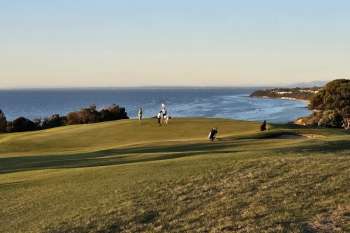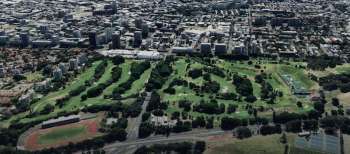So Tiger Woods has decided to play the 2009 Australian Masters and, as reports would have us believe, it wasn’t the hefty appearance fee, part-paid by the Victorian Government, that swayed him to make the trip but rather the venue for the tournament, Melbourne’s Kingston Heath Golf Club. Whether spin or a legitimate deciding factor, what’s undeniably true is that other stars in this year’s field are only playing the Masters because the event was shifted to a more worthy facility. Tiger himself hasn’t played Kingston Heath before, but it is a world-regarded member of the Sandbelt, and he is forever espousing the virtues of golf in this region, even declaring recently that the ‘Aussie Sandbelt’ was his favourite area to play.
Given the eyes of the golfing world will be upon us this month, it’s worth spending some time looking at Kingston Heath, and comparing it to some of the courses Tiger is used to playing elsewhere in the world. Much of the layout here dates back to 1925, when Dan Soutar’s holes were first opened for play. Soutar had designed the course for a committee of founding members that was led by Stanley Dutton Green, a Melbourne solicitor who had corresponded with golfing greats Harry Vardon and J.H. Taylor on the subject of golf course design. With the advent of steel shafted clubs and the popularisation of the rubber-cored ball, Vardon’s advice for Dutton Green was to ensure the new layout was built of sufficient length to ‘stand the test of time’. Soutar and the founding members stuck rigidly to this ethos, building a course that was longer and more demanding than any other in Australia at the time.
It has been said that English architect Dr. Alister MacKenzie aired concerns about the length of Kingston Heath during his inspection of the layout in 1926. When he departed, however, the club steadfastly refused to shorten any of its holes, aside from the 15th which MacKenzie suggested be converted from a short, blind par four into an uphill par three. MacKenzie’s impact at Kingston Heath should never be underestimated, the 15th is a work of genius and his bunkering scheme completely transformed the site, and is still regarded by many as the finest in existence. More than this, however, he validated the direction the club had taken, perhaps not so much in terms of the difficulty of the course but certainly in terms of the routing, design style and general turf maintenance.
Not surprisingly, during the past 80 years the Kingston Heath layout has grown even longer, but only by around 150 metres. Compare this to other classic championship venues here and overseas, many of which have been stretched and altered almost beyond recognition. Medinah No. 3 in America is perhaps the most extreme example, Tom Bendelow’s initial creation having been remodelled several times and extended more than 1,000 metres since first opening in the 1920s.
The changes made at Medinah highlight both the shortcomings with that particular golf course, but also the difference between the mindset of golf clubs here and in America regarding technology and protecting the integrity of their original designs. While changes have been made at The Heath over the years, structurally the holes are still arranged largely as first intended. As a result, the obscene technological advances made in our game during the past two decades have made the course less difficult, but they certainly haven’t rendered it obsolete.
The chief reason for this is strategic bunkering and wicked green contours that are capable of tormenting modern golfers when presented in firm and fast condition. It’s important to remember, however, that these greens were not actually designed to be as severe as they are today, the targets at Kingston Heath created back when green speeds on the Stimpmeter were closer to 10 than 15. This is also true of famed tournament venues abroad. In America the targets at places like Augusta National, Oakland Hills, Winged Foot, Oakmont and Pinehurst No. 2 are notoriously treacherous, yet green speeds at these legendary clubs are now much quicker than the putting contours were initially designed to handle. Of course most older American clubs have also tried to further combat technology by pushing back tees, pinching fairways, adding bunkers and growing thicker and thicker roughs.
The lengthening and narrowing of America’s Golden Age gems for the sake of tournament relevance has become so widespread that it would now be almost impossible for a ‘short’ track there to be seriously considered as a championship venue. Thankfully we are not as hung up about protecting par here in Australia, and rather than watching our leading professionals struggle we understand that if they play well and conditions are favourable then they ought to be shooting red numbers. It’s a similar philosophy in Britain, where most of the older links have been lengthened and altered in places to keep pace with the modern game, but importantly green speeds generally remain moderate and only marginally quicker than first intended. America is a different story altogether, with a large portion of their old tournament layouts having become longer, tighter, faster and more penal over the years, and certainly less fun to play.
The same cannot be said of Kingston Heath, which remains a joy for the average golfer, and a genuine challenge for the game’s best professionals. While the course may appear much simpler than the beefed-up torture tests we see Tiger and co tackling during the US majors each year, it won’t be a pushover, especially if we get some decent winds. For those more interested in the golf course than the golf tournament, use the Aussie Masters to take a close look at the MacKenzie bunkering and also the use of native vegetation, which is beautifully employed here to give the property a greater sense of space and grandeur. The outstanding holes on this layout are very obvious, but others worthy of study include the 6th, 8th, 12th and 14th, each using what are quite subtle ground undulations to great effect. The green sites also merit admiration, none are dull and many feature shapes that are more complex than is immediately apparent. Birdies anywhere here from the above the hole are certainly well earned.
Tiger should enjoy his time in Melbourne, and playing in front of such appreciative and knowledgeable sports fans. To win around The Heath he’ll need his short game and putting stroke to be major-championship sharp. It also helps to keep the ball in play, his length sure to be an asset as it allows him to manoeuvre his ball around the tight layout by using plenty of piercing irons and fairway woods off the tee. He will clearly enter the tournament as favourite to win, but our best local golfers have a considerable home-ground advantage and if the likes of Ogilvy, Allenby, Appleby and Baddeley can play well we should be in for an exciting four days of golf.
Aside from some decent competition, my big hope for the week is that the assembled media ask more pertinent questions of Tiger than the obligatory enquiry about the Nicklaus record or what he thinks of Australia. Woods recently established his own golf course design business, and it would be great to instead focus on his global legacy and ambitions as a course creator. When he announced plans to establish Tiger Woods Design he declared that his tastes were ‘toward the old and traditional’, so lets hope for something illuminating on Sandbelt golf and perhaps the specific holes at Kingston Heath. Personally I’d love to hear what he thinks of the 15th, and whether he would ever consider building a green so steep. What about the 3rd, with its open and straightforward fairway but severe target area. Is this the type of short par four he admires or does he prefer an American approach to the short-four, where both fairway and green are anorexic and totally surrounded by trouble? Does he view the blind approach into the 17th green as simply a solution to an awkward routing situation or is this a genuine design tactic to be employed more frequently? Tiger has a reputation for intelligent play, and it would be fascinating to find out whether his approach to design is equally cerebral.
Regardless of who wins the 2009 Australian Masters, it’s refreshing to once again see our premier events being played at our premier clubs, remembering it was only two years ago that the ‘Big Three’ were hosted by Huntingdale, Hyatt Coolum and The Australian. Golfers like Tiger Woods needn’t travel halfway around the globe in order to experience this style of golf course. Kingston Heath is something different altogether and, along with the New South Wales Golf Club (venue for the Australian Open in December), is the sort of quality layout the PGA Tour should be showcasing to the world. Not only are both tracks rated among the best three or four in Australia, they sit easily among the elite 30 or so courses on the planet. As for how Kingston Heath will handle an event of this scale, I’ve no doubt the Masters will be a success and when it’s over players and event organisers are likely to be left wondering why they persisted so long at Huntingdale.
Darius Oliver, Architecture Editor Australian Golf Digest




